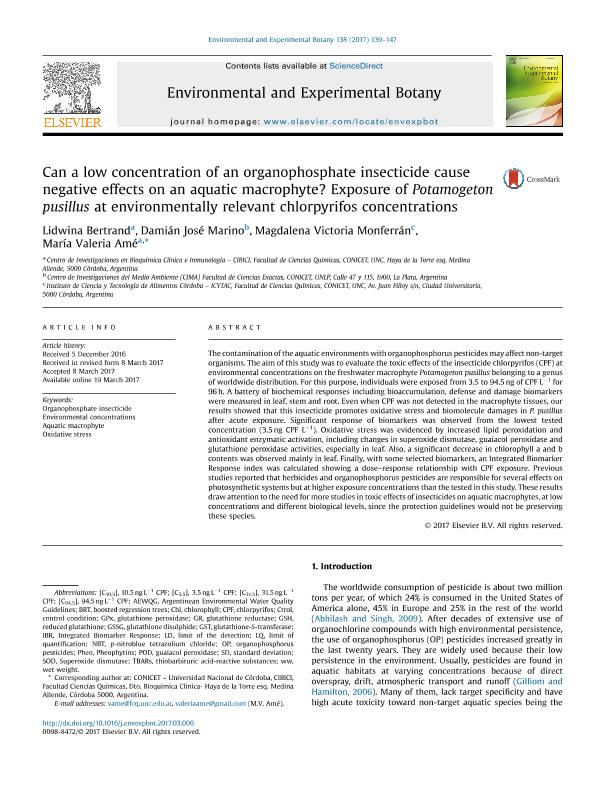Mostrar el registro sencillo del ítem
dc.contributor.author
Bertrand, Lidwina

dc.contributor.author
Marino, Damian Jose Gabriel

dc.contributor.author
Monferran, Magdalena Victoria

dc.contributor.author
Amé, María Valeria

dc.date.available
2018-11-09T13:37:44Z
dc.date.issued
2017-06
dc.identifier.citation
Bertrand, Lidwina; Marino, Damian Jose Gabriel; Monferran, Magdalena Victoria; Amé, María Valeria; Can a low concentration of an organophosphate insecticide cause negative effects on an aquatic macrophyte? Exposure of Potamogeton pusillus at environmentally relevant chlorpyrifos concentrations; Pergamon-Elsevier Science Ltd; Environmental and Experimental Botany; 138; 6-2017; 139-147
dc.identifier.issn
0098-8472
dc.identifier.uri
http://hdl.handle.net/11336/64058
dc.description.abstract
The contamination of the aquatic environments with organophosphorus pesticides may affect non-target organisms. The aim of this study was to evaluate the toxic effects of the insecticide chlorpyrifos (CPF) at environmental concentrations on the freshwater macrophyte Potamogeton pusillus belonging to a genus of worldwide distribution. For this purpose, individuals were exposed from 3.5 to 94.5 ng of CPF L−1 for 96 h. A battery of biochemical responses including bioaccumulation, defense and damage biomarkers were measured in leaf, stem and root. Even when CPF was not detected in the macrophyte tissues, our results showed that this insecticide promotes oxidative stress and biomolecule damages in P. pusillus after acute exposure. Significant response of biomarkers was observed from the lowest tested concentration (3.5 ng CPF L−1). Oxidative stress was evidenced by increased lipid peroxidation and antioxidant enzymatic activation, including changes in superoxide dismutase, guaiacol peroxidase and glutathione peroxidase activities, especially in leaf. Also, a significant decrease in chlorophyll a and b contents was observed mainly in leaf. Finally, with some selected biomarkers, an Integrated Biomarker Response index was calculated showing a dose–response relationship with CPF exposure. Previous studies reported that herbicides and organophosphorus pesticides are responsible for several effects on photosynthetic systems but at higher exposure concentrations than the tested in this study. These results draw attention to the need for more studies in toxic effects of insecticides on aquatic macrophytes, at low concentrations and different biological levels, since the protection guidelines would not be preserving these species.
dc.format
application/pdf
dc.language.iso
eng
dc.publisher
Pergamon-Elsevier Science Ltd

dc.rights
info:eu-repo/semantics/openAccess
dc.rights.uri
https://creativecommons.org/licenses/by-nc-sa/2.5/ar/
dc.subject
AQUATIC MACROPHYTE
dc.subject
ENVIRONMENTAL CONCENTRATIONS
dc.subject
ORGANOPHOSPHATE INSECTICIDE
dc.subject
OXIDATIVE STRESS
dc.subject.classification
Meteorología y Ciencias Atmosféricas

dc.subject.classification
Ciencias de la Tierra y relacionadas con el Medio Ambiente

dc.subject.classification
CIENCIAS NATURALES Y EXACTAS

dc.title
Can a low concentration of an organophosphate insecticide cause negative effects on an aquatic macrophyte? Exposure of Potamogeton pusillus at environmentally relevant chlorpyrifos concentrations
dc.type
info:eu-repo/semantics/article
dc.type
info:ar-repo/semantics/artículo
dc.type
info:eu-repo/semantics/publishedVersion
dc.date.updated
2018-10-22T18:18:16Z
dc.journal.volume
138
dc.journal.pagination
139-147
dc.journal.pais
Estados Unidos

dc.journal.ciudad
Nueva York
dc.description.fil
Fil: Bertrand, Lidwina. Consejo Nacional de Investigaciones Científicas y Técnicas. Centro Científico Tecnológico Córdoba. Centro de Investigaciones en Bioquímica Clínica e Inmunología; Argentina
dc.description.fil
Fil: Marino, Damian Jose Gabriel. Consejo Nacional de Investigaciones Científicas y Técnicas. Centro Científico Tecnológico Conicet - La Plata; Argentina. Universidad Nacional de La Plata. Facultad de Ciencias Exactas. Departamento de Química. Centro de Investigaciones del Medio Ambiente; Argentina
dc.description.fil
Fil: Monferran, Magdalena Victoria. Consejo Nacional de Investigaciones Científicas y Técnicas. Centro Científico Tecnológico Conicet - Córdoba. Instituto de Ciencia y Tecnología de Alimentos Córdoba. Universidad Nacional de Córdoba. Facultad de Ciencias Químicas. Instituto de Ciencia y Tecnología de Alimentos Córdoba; Argentina
dc.description.fil
Fil: Amé, María Valeria. Consejo Nacional de Investigaciones Científicas y Técnicas. Centro Científico Tecnológico Córdoba. Centro de Investigaciones en Bioquímica Clínica e Inmunología; Argentina
dc.journal.title
Environmental and Experimental Botany

dc.relation.alternativeid
info:eu-repo/semantics/altIdentifier/doi/https://dx.doi.org/10.1016/j.envexpbot.2017.03.006
dc.relation.alternativeid
info:eu-repo/semantics/altIdentifier/url/https://www.sciencedirect.com/science/article/pii/S0098847217300746
Archivos asociados
